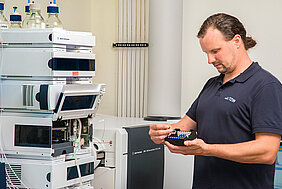When small, polar and mobile substances are discussed as water contaminants, scientists often speak of PMT/vPvM substances, PMOC, SMS and hot-targets and it is not always easy to keep the overview.
Joint project of the UBA (German Environment Agency) and TZW
Although we are dealing with formally different terms or definitions, these classifications all pursue the same purpose in principle: to identify substances relevant to drinking water and to protect our water bodies as well as our drinking water from harmful influences. The German Environment Agency (UBA) and TZW have already been very committed in the past to derive the drinking water relevance of anthropogenic chemicals on the basis of their intrinsic substance properties or from the data submitted for substance registration. Along with other partners, these forces and expertise are now being combined in a joint research project in the field of preventive resource protection.
In order to protect the environment and human health as a precautionary measure, the Drinking Water Ordinance stipulates that the input of persistent chemicals into surface waters and groundwater must be avoided or kept as low as reasonably achievable. This is also called ALARA principle: As Low As Reasonably Achievable. Nevertheless, it does happen that anthropogenic substances can also be detected in treated drinking water. On behalf of the German Environment Agency, researchers from TZW, IWW Zentrum Wasser, the Fresenius University of Applied Sciences and the Norwegian Geotechnical Institute are now working together to ensure that impairments of water resources are a thing of the past and that greater importance is attached to the precautionary principle, also internationally. Initially, all substances registered under the REACH regulation by mid-2019 are to be evaluated with regard to their PMT/vPvM properties (PMT: persistent, mobile, toxic or vPvM: very persistent and very mobile) and substances will be prioritized. In the further course of the project, the findings of these substances in European drinking water resources will be examined by means of literature research and water analyses. Subsequently, TZW will evaluate the effectiveness of technical removal options as risk control measures with regard to their application to the most relevant substances.
Achieve emission reduction with the REACH regulation
The overall objective of this project is to further develop the hazard based management under REACH Regulation. Regulatory Management Option Analyses (RMOA) are to be developed and about 10 substances will be recommended to the German Environment Agency for regulation under REACH, because emission reduction is still the most effective protection of water resources.
Project
PMT/vPvM substances: Identification and Regulation under REACH
Links
Scientific article on SMS substances (Substances from Multiple Sources)
UBA report on PMT/vPvM substances
Article on prioritisation and regulation projects in Germany
Publication
Neuwald, I. J.; Hübner, D.; Wiegand, H. L.; Valkov, V.; Borchers, U.; Nödler, K.; Scheurer, M.; Hale, S. E.; Arp, H. P. H.; Zahn, D.: Ultra-Short-Chain PFASs in the Sources of German Drinking Water: Prevalent, Overlooked, Difficult to Remove, and Unregulated. Environmental Science & Technology 56, 6380-6390 (2022)
DOI: https://doi/10.1021/acs.est.1c07949
Neuwald, I. J.; Hübner, D.; Wiegand, H. L.; Valkov, V.; Borchers, U.; Nödler, K.; Scheurer, M.; Hale, S. E.; Arp, H. P. H.; Zahn, D.: Occurrence, Distribution, and Environmental Behavior of Persistent, Mobile, and Toxic (PMT) and Very Persistent and Very Mobile (vPvM) Substances in the Sources of German Drinking Water. Environmental Science & Technology 56, 10857–10867 (2022)
DOI: https://doi.org/10.1021/acs.est.2c03659

![[Translate to English:] Prüfstelle-Produktprüfung_Teststand Test centre and product testing](/fileadmin/_processed_/0/9/csm_TZW-Karlsruhe_Pruefung_Geraete-Teststand_377188946c.jpg)
























